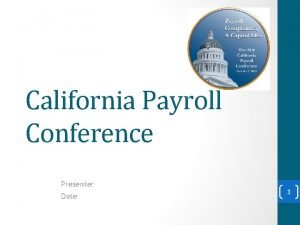Nottingham Trent University Alternative Futures Conference 2014 The















- Slides: 15

Nottingham Trent University Alternative Futures Conference 2014 The OECD concept of the ‘Strategic State’ and its application to 3 inter-related areas of public service improvement in England from 1997 -2013. Pete Murphy Nottingham Business School Public Management and Governance Research Group 26 th February 2014

The Strategic State • Investigating the coherence of public sector reform for locally delivered public services utilizing the OECD concept and definition of the Strategic State • "To put in place and effective strategic management system, central agencies must act as a central leadership hub in order to facilitate co-ordination, collaboration and co-operation across the public administration, with the objective of securing a strong, coherent and collective strategic vision of where the country needs to go and how it will get there. • Centres of Government are the focal point for the strategic state and are essential for leadership, steering, stewardship, oversight and accountability. "

3 inter-related delivery areas in local authorities • The corporate performance of local authorities and their performance management regimes. • The financial performance of local authorities and their financial management regimes. • The performance of Sport and Recreation Services and their performance regimes.

Why Local Authorities • Their performance management regime became the ‘model’ for similar regimes across the public services. • They made sustained and consistent improvements across all services and parts of the country during the period to 2010. • There is open access to publically available quality assured, comparable data and intelligence.

Corporate performance • Management system – CSR/PSA system in Central government aligned to performance management in locally delivered services • Collective Strategic Vision – Modernisation, citizen centred services and continuous improvement • Leadership, steering, stewardship, oversight and accountability – Tripartite arrangements and co-increasing production between government, LGA and Independent inspectors and auditors

Methodology and Evidence 1. Within Central Government i. e. between the ‘centre of government’ and the ‘spending departments’ of central government. • Comprehensive Spending Reviews (budget allocations) and Public Service Agreements (performance objectives and targets). 2. Between Central and Local Government. • a) Top down performance management regimes (Best Value, Comprehensive Performance Assessments, Comprehensive Area Assessments) • b) Central/Local Agreements, negotiated around strategic priorities (Local Public Service Agreements, Local Area Agreements and Multi-Area Agreements). • c) Central Government Intervention in ‘failing’ or significantly underperforming services (Service inspections and interventions; organisation inspections and interventions and multiple organisational inspections and interventions).

Conclusions • Between 1997 and 2010, there was considerable evidence of strategic state action in relation to locally delivered public services. • This has given way to a less coherent approach as the coalition government has prioritized short and medium term reductions in public expenditure and market based responses to public service reform. • Murphy, P. 2014 (forthcoming) The Development of the Strategic State and the Performance Management of Local Authorities in England. Joyce, P. and Drumaux, A. Eds Public Organizations: European Practices and Perspectives Taylor & Francis/Routledge New York

Financial Performance • An area in the current period of austerity where you might expect more scrutiny and more sophisticated scrutiny. • Financial framework in local authorities became the ‘model’ for similar financial assessments of locally delivered across the public services and a new model (independently and externally audited) was introduced through the National Audit Office • There were sustained and consistent improvements across all organizations and services in all parts of the country during the period to 2010 and there is access to publically available quality assured, comparable data and intelligence. • It may be possible to do some international comparisons.

Phases of the development of local fiduciary and financial management • 1983 - 2002 system of Regularity Audits, Value for Money, Public Interest Reports, Nolan Standards • 2002 - 2004 The first Use of Resources Assessment framework • 2005 – 2008 The CPA Harder test included a new Uo. R framework (Local government and Health) • 2009 – the CAA and Uo. R – transferred public costs • Post election – responsibility transferred from the Audit Commission to the National Audit Office

Methodology and Evidence • 2002 -2010: Similar to Corporate investigation assessments (historical documentary evidence) supported by elite interviews • Post 2010 – as above but supplemented by a series of interviews of current senior managers in Local Authorities NHS and Further Education

Basis of comparisons (Deconstructed from OECD definition) Coherence of vision Inclusiveness of key stakeholders Quality and robustness of the evidential base Strategic nature of central interventions Integrated consistent and mutually supportive short, medium and long term policies and plans. • Openness and transparency of scrutiny • • •

Post 2010 Emerging Findings • Vision – changed to cutback management • Key stakeholders have become less engaged and integrated • Evidence base is fracturing • CSR 2010 adopted 4 year focus but deliverers say ad hoc and incremental • Loss of external scrutiny

Sport and Recreation • An area that was not considered ‘strategic’ by all stakeholders • The 2012 Olympics were clearly a strategic issue • The services became more important as indirect benefits of physical activity and behavioural change across multiple agendas (particularly health) became apparent. • Service provision is generally considered to be significantly prone to reductions in the current era of austerity

1997 -2013 Emerging Findings • Vision – increased participation not achieved and means to this end varied and never consistent • Key stakeholders – changed eg LAs, Health, National Bodies • Evidence base always poor • Funding inconsistent

Questions?
 Trent university campus
Trent university campus University of nottingham parking permit
University of nottingham parking permit University of nottingham
University of nottingham Shadow payroll example
Shadow payroll example Payroll conference 2014
Payroll conference 2014 Payroll conference 2014
Payroll conference 2014 Trent hoover wrestling
Trent hoover wrestling Trent global college
Trent global college Michael cervenka
Michael cervenka The final decrees of the council of trent
The final decrees of the council of trent Trent global
Trent global Problems in the catholic church reformation
Problems in the catholic church reformation Trent 2018
Trent 2018 Flask jaeger
Flask jaeger Trent harkrader
Trent harkrader Council of trent ap euro
Council of trent ap euro





























